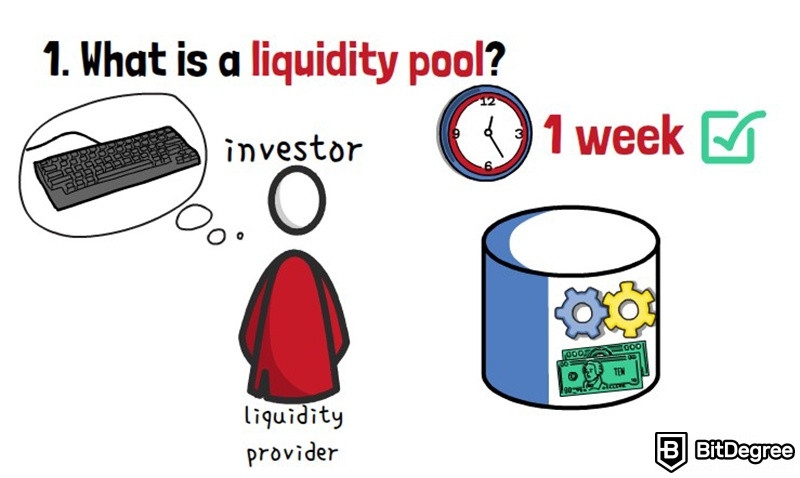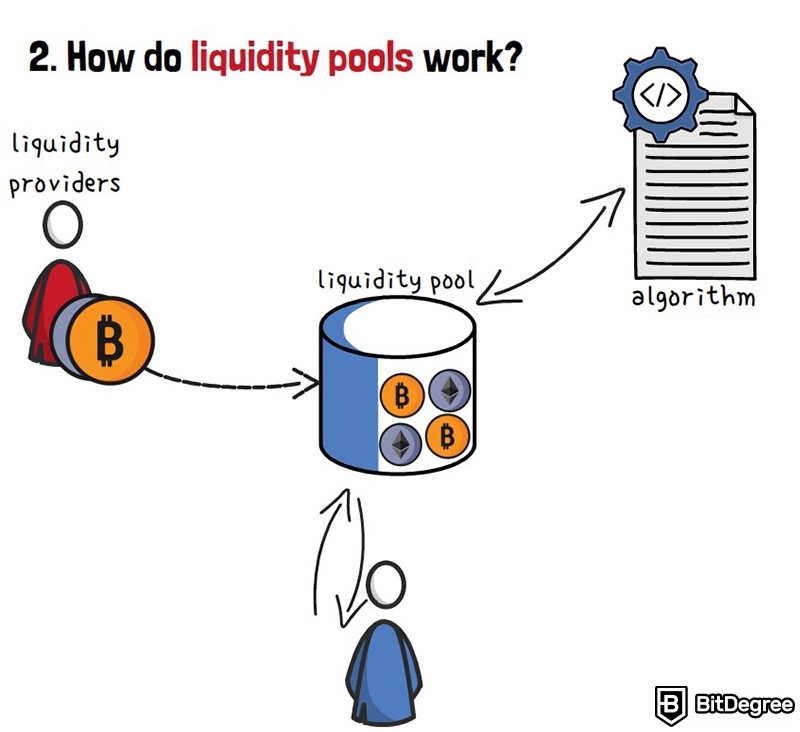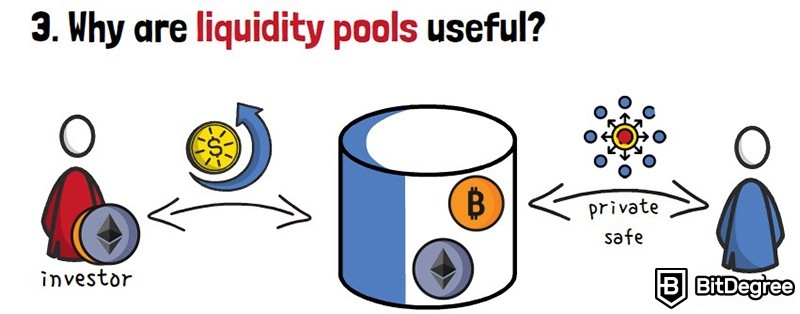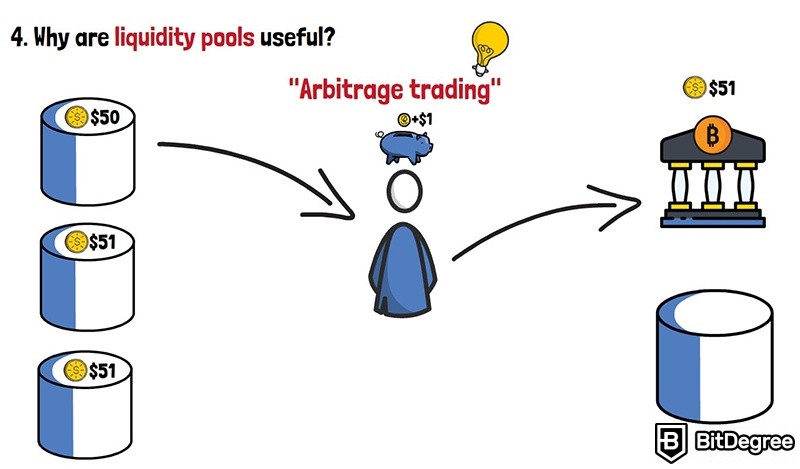What is a Liquidity Pool and How Does It Work?
In this section, we’re going to be answering the question of what is a Liquidity Pool in Crypto.
Imagine that you have $100 of spare money - money that you don’t need at this point in time, and can use at your leisure. Now, one day you are approached by your friend, who offers you a deal - both of you throw your $100 bills into a pot, invite a few other friends to do the same, and then allow other people to use the money from that pot. In turn, you will earn passive interest over time.
In essence, this is a very broad explanation of how a liquidity pool works. In this section, we’ll answer questions such as what a liquidity pool is, how it works, and why such a concept is useful, in the first place.
Let’s not waste any time and get right to it!

Video Explainer
Video Explainer: What is a Liquidity Pool and How Does It Work?
Reading is not your thing? Watch the "What is a Liquidity Pool and How Does It Work?" video explainer
What is a Liquidity Pool in Crypto? (Animated)


What is a Liquidity Pool?
Firstly, let’s establish what exactly is a liquidity pool. There are two ways how you can look at it - as an investor, and as someone who will actually use the pool.

First, let’s discuss the investor’s point of view.
A liquidity pool is a place where you can lock up your money or a specific asset, for a set amount of time. If you do so, you’ll be called - a liquidity provider. Referencing the example given at the beginning of this section, imagine that you and your friend decide to throw your $100 bills into a pot for a week - after a week, you need that money for a new keyboard! Well, liquidity pools allow you to take your money out, usually without any problems, and at any point in time.
In the upcoming week, you are free to go on with your life - there is nothing else that you need to do in regards to that pot. Liquidity pools allow your money to work for you - after a week, you might come to find that your $100 has now turned into $110!
Now, obviously, this is just an example, and the rate at which you will earn the passive interest will vary from pool to pool, but you get a general idea, nonetheless. Think about it this way - some pots will be old and barely usable, while others - embedded with fancy jewels and made out of gold. Thus, your earnings will differ, accordingly!
Now, you do need to know that you can provide other crypto assets to the liquidity pool, and not only fiat money. It all depends on the pool. For example, some liquidity pools might allow you to earn interest on Bitcoin, Ethereum, and other super-popular cryptocurrencies!
From a liquidity provider's point of view, that’s the general idea of how a liquidity pool works. It’s rather simple, on the surface level - you put money in, hoping that, in some time, you’ll take out a bit more.
Moving on, in order to understand the use cases of liquidity pools from the user side of the table, we need to take a look at how these pools work, in the first place.
How Do Liquidity Pools Work?
Imagine that it’s a beautiful summer day outside, and you’re sitting in your room, all jolly and relaxed. Suddenly, you remember that you’re in need of a new laptop - your old computer is laggy and worn down, and takes about 26,5 years to turn on. Being in a great mood, you decide that it’s time to order a new laptop.
You find one that you like online and go through the checkout process. Here, you need to put in your personal information, name and surname, address, and your bank information. This is all fine and dandy, however, what if you DON’T want to do that?
Specifically, what if you DON’T want the shop to know all of your information? Well, what if there was a way to purchase the computer, without actually providing any personal details about yourself - simply sending the money, and receiving the new laptop at a specified location, without involving any other third-party human beings into the process?
Well, in a very rough way, this is how DEXes - decentralized cryptocurrency exchanges - work. These exchange platforms allow users to trade different crypto coins and tokens without having to provide personal information to any specific, centralized institution.
Now, I’ve mentioned coins and tokens - if you’d like to learn more about the differences between the two, don’t forget to check out the section "Coin VS Token".
In order for decentralized exchanges to function properly in an automated manner, they need to have some sort of an asset pool. It’s like a car and fuel - while the car might be awesome, if it has no fuel, it’s useless. This is where liquidity pools come in.
Namely, liquidity pools allow decentralized exchanges to function, in the first place. When you come to trade on a DEX, and want to, say, sell your tokens, liquidity pools allow you to do so - they hold some of those tokens inside of themselves, and pay out the crypto that you want for the tokens.
To understand the process clearly, you should know that, fundamentally, trades were based on so-called Order Books. In short, the idea of an Order Book is to match a buyer with a seller, and finally close their deal.

With the Order Book, sellers will set the minimum price of the assets they want to sell, and buyers will set the maximum price they are willing to pay for such assets. If the system matches the seller and buyer, both with the same set price for the same item, it finalizes the deal. This is a classic way of functioning for any marketplace.
With Liquidity Pools, it's a different story, and Order Booking is not needed here anymore! A simple illustration of the same trade process with a Liquidity pool would look like this:
First of all, as I mentioned earlier, the liquidity pool is filled with a bunch of funds provided by liquidity providers. When you’re buying or selling your desired coin on a liquidity pool, there is no seller or buyer on the other side, as we tend to have them normally with the Order Book. Instead, you always trade with the pool itself. All your and pool activities are governed by the automated algorithm in a smart contract.

Prices of our trades are also managed by this algorithm, based on the current and historical trades that happened in that pool. So, no humans are needed on the other side, to make the trade happen, because everything that happens is between you and a programmed algorithm that is launched on a blockchain, and can’t be changed.
In short, by default, a pool is filled with a 50/50 ratio of 2 coins. Let’s say, it’s 50% Bitcoin, and 50% Ethereum. After you start buying Bitcoins with your Ethereum in that pool, the pool starts losing its Bitcoins and obtaining more and more Ethereum coins from you.
In this case, the algorithm of the pool will incrementally raise the price of the Bitcoin and lower the price of Ethereum, because it clearly sees the demand of Bitcoin and the supply of Ethereum. This is the automated pool reaction to the market needs, everything is self-regulated.
Also, this illustration answers the question why liquidity pools are looking for more and more liquidity investors. And the answer is - the bigger the pool and sum of assets in it, the less it’s sensitive to massive buy and sell trades, and the price algorithm of the assets stays less sensitive to the market itself, because, with each trade, the pool will obtain or lose just a little amount of assets, when compared to the whole liquidity pool size.
Now, allow me to be clear - the processes behind liquidity pools are far more complicated than that. There are a ton of different features related to these projects, and each pool needs to be developed and programmed using smart contracts and advanced coding logic.
For your average person, though, all of that is trivial. You aren’t going to need to know the intricacies of liquidity pools in order to use them. Suffice to say that liquidity pools hold two or more assets (cryptocurrencies, USD, and so on) inside of them, and allow people to trade on decentralized exchange platforms.
In turn, while individuals use the pools for their trades, investors will receive interest on their investments, over time. Simple!
Why are Liquidity Pools Useful?
Now that you have a better idea of what liquidity pools are and how they work, let’s explore the concept of why anyone would want to use these pools in the first place.

We’ve already covered the very general ideas of why someone might want to use liquidity pools - investors want to earn a premium, while traders are able to trade the cryptocurrencies that they want, on decentralized exchanges, thanks to those same liquidity pools. However, the reasoning goes much deeper, too.
Imagine that you’re trading on a centralized, well-known cryptocurrency exchange. Suddenly, the price of Bitcoin drops by 40%, out of the blue. What do you think happens next?
If you said “panic”, you’re definitely correct.

Fearing further price plunges, thousands of traders and their pets rush to the exchange, in order to sell their BTC. While all of this is happening, the CEO of the exchange sees that the situation is dire - they are running out of fiat money, and their servers are crashing.
The CEO decides to freeze the transactions - in other words, you are no longer able to sell your BTC on the exchange. Just to be clear, the managing staff of a centralized exchange is always prepared to pull the kill-switch, and to turn off our trading party if a situation starts moving away from their interests.
THIS is exactly why decentralized exchanges are popular and useful. No one person can dictate what happens with a DEX simply because he got out of bed on the wrong foot that morning. And liquidity pools allow these DEXs to remain decentralized, in the first place!
On top of that, if the aforementioned CEO freezes the operations of their exchange, as discussed earlier, this will impact the price further - people will start panicking even more! On a decentralized exchange, liquidity pools are the ones that dictate the price of an asset - they are not impacted by bad mood or weather.
Sure, the price will follow the market, but it will be less prone to various forms of manipulation. Once again, this is thanks to the logic behind liquidity pool development.
Also let’s not forget about market-making mechanisms on some centralized exchanges, where sneaky exchange owners deal with specific coin creators so that the exchange will move their coins by buying and selling them hundreds of times, without any fee, to create a volume and some sort of activity of the so-called “shitcoin”, to make it look like an active project with thousands of active transactions, buyers and sellers.

By doing so, they try to imitate activity and look prettier to potential investors on the market. And this is one of the darkest things on centralized exchanges, especially with new, less-known altcoins.
Another use for liquidity pools among traders is “arbitrage trading”. A very fancy term, sure, but the concept is actually very simple! Traders try to search for many liquidity pools with the best prices of an asset lying within, and then buy that asset, so that they could trade it on centralized or even other decentralized exchanges, and make a profit with a difference in doing so.
Let's imagine a trader finds the DEX that currently trades some coin or token for $50 per coin. After buying these tokens, he goes to a different exchange with a higher bid price for the same coin and sells it there for $51 per coin. By doing so, his profit is $1 per coin, and this is huge!

Arbitrage trading requires a lot of experience and discipline, but it’s one of the more common uses for liquidity pools, nonetheless. It’s made possible due to the common asset price differences between centralized exchanges and liquidity pools.
All in all, there’s a lot more when it comes to liquidity pools, but the information discussed in this section should serve as a great starting point for beginners.












